
- •1 Introduction
- •Purpose of the Study
- •Research Questions.
- •Key Words
- •1.4 Significance of the study
- •2 Literature Review
- •2.1 Nahuatl
- •2.1.1 History Nahuatl civilization
- •2.1.2 Nahuatl grammar
- •Nahuatl in Puebla
- •Figure 2.2.2
- •2.2.1The Mixtec of Puebla
- •2.3 Education in Mexico
- •2.3.1 The history of the indigenous education in Mexico
- •2.4 Bilingual education at present
- •2.4.1 Benefits of bilingual education
- •2.5 Critical Pedagogy.
- •2.6 The role of the school and family in the bilingual education
- •2.6.1 Empowering Parents
- •2.6.2 How oral tradition can be used to teach academic skills
- •3. Methodology
- •3.1 Subjects
- •3.2 Instruments
- •3.3 Interviews
- •3.4 Activities
- •4. Findings
- •Answers of interview made to adults.
- •4.2 Answers of interview made to teenagers.
- •4.3 Answers of interview made to children.
- •4.4 Results of activities applied to children
- •5. Conclusions
- •5.1 General overview
- •5.2 Implications for further study.
- •5.3 Limitations of the study
- •5.4 Directions for further research
- •Appendix 1: Poster used to let people know about the conference.
- •Appendix 4: the questionaire administered to parents
- •Appendix 5: the questionaire administered to teenagers
- •Appendix 10: legend of the lagoon of xochiltepec in spanish
- •Appendix 11: legend of the lagoon of xochiltepec in nahuatl
Appendix 1: Poster used to let people know about the conference.
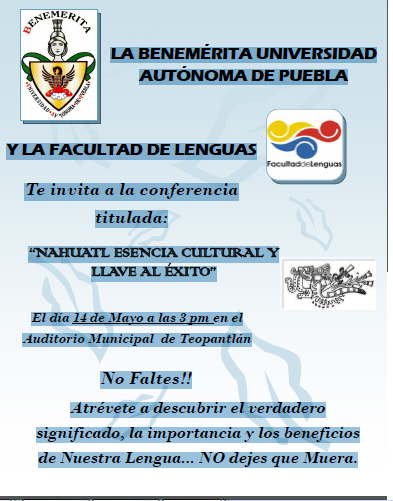
APPENDIX 2: INVITATION GIVEN TO PARENTS OF THE BILINGUAL SCHOOL
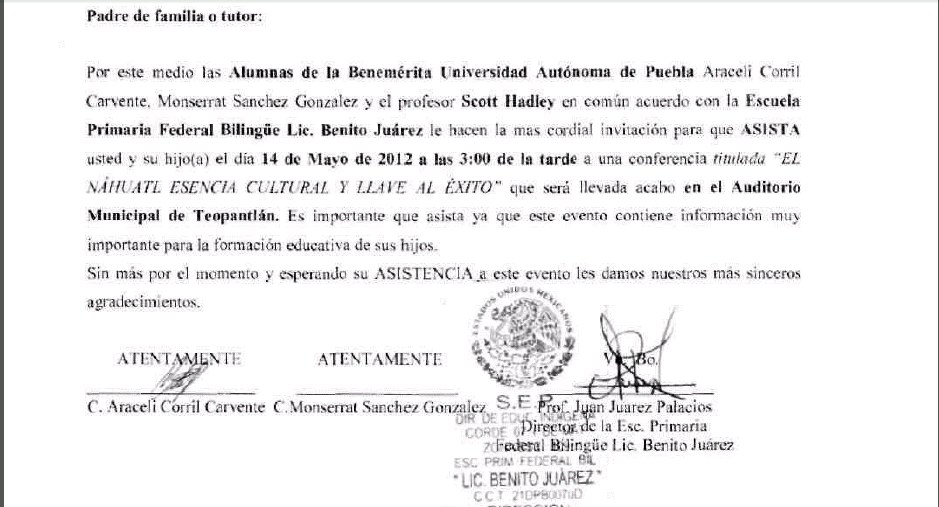
APPENDIX 3: PAMPHLET GIVEN ON THE STREET TO PEOPLE IN GENERAL AND PEOPLE IN THE CONFERENCE
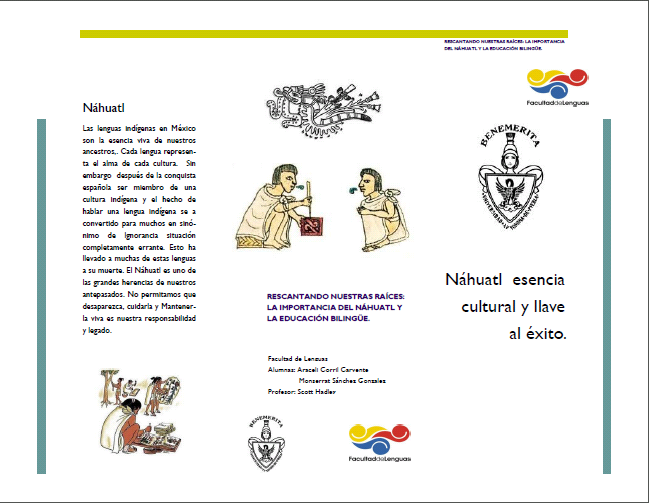
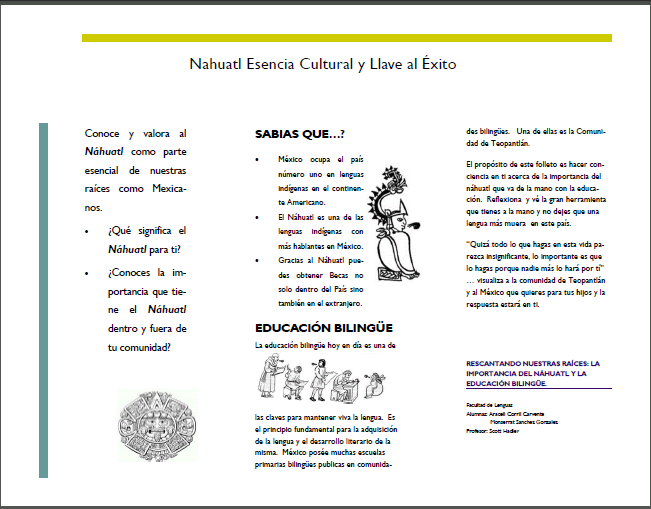
Appendix 4: the questionaire administered to parents
Este cuestionario tiene como propósito investigar que significa para los padres de familia su lengua madre el cual es el Nahuatl y que significa para ellos la Educación Bilingüe a fin de diseñar un método para difundir la lengua Nahuatl a través de métodos de enseñanza y así evitar su extinción.
Interview to parents.
1¿Cuál es su lengua madre?
2 ¿Habla usted el náhuatl?
3 ¿Es importante es el náhuatl para usted?
4 ¿Sabe que el náhuatl está en peligro de extinción?
5 ¿Sabe de los beneficios que tiene ser hablante del náhuatl?
6 ¿Qué haría para evitar su extinción?
7 ¿Qué significa una escuela bilingüe indígena para usted?
8 ¿está de acuerdo en que existan este tipo de escuelas?
9 ¿Tiene hijos estudiando?
10 ¿Por qué eligió esa escuela? ¿Qué opina de la escuela bilingüe que está en la comunidad?
Appendix 5: the questionaire administered to teenagers
Este cuestionario tiene como propósito investigar que significa el Nahuatl para estudiantes de entre 13-25años de edad y que significa para ellos la Educación Bilingüe a fin de diseñar un método para difundir la lengua Nahuatl a través de métodos de enseñanza y así evitar su extinción.
Edad
1 ¿Cuál es tu lengua madre?
2 ¿Hablas náhuatl?
3 ¿Qué es el náhuatl para ti?
4: ¿Es importante el náhuatl para ti?
5 ¿Sabes que beneficios se obtiene al ser hablante del náhuatl?
6 ¿Sabes que el náhuatl está en peligro de extinción?
7 ¿Crees que es importante preservar el náhuatl?
8 ¿Qué harías para evitar su extinción?
9 ¿Qué significa para ti una escuela bilingüe indígena?
10 ¿Estás de acuerdo en que existan este tipo de escuelas?
11 ¿Si tuvieras la oportunidad de elegir una escuela bilingüe lo harías?
12 ¿En el futuro inscribirías a tus hijos a una escuela indígena?
APPENDIX 6: THE QUESTIONAIRE ADMINISTERED TO CHILDREN
Este cuestionario tiene como propósito investigar que significa el Nahuatl para estudiantes de entre 9-11años de edad y que significa para ellos la Educación Bilingüe a fin de diseñar un método para difundir la lengua Nahuatl a través de métodos de enseñanza y así evitar su extinción.
¿Hablas Náhuatl?
¿Es importante el Náhuatl para ti?
Si ___ No ____
¿Qué tanto hablas y entiendes el Nahuatl?
No lo hablo y entiendo poquito ___
Hablo muy poco pero entiendo ___
Lo hablo y entiendo muy Bien ___
¿Con quién hablas Nahuatl?
Con mis papás y con mis abuelitos ___
Con mis amigos y compañeros ___
Con todos ___
¿Te gusta hablar en Náhuatl?
SI __ NO __
¿Sabes que el Náhuatl está en peligro de extinción?
Si __ No __
¿Sabes que tu escuela es una Escuela Bilingüe?
Si ___ No ___
¿Te gusta esta escuela?
Si ___ No ___
¿Con que frecuencia hablas en Nahuatl en tu escuela?
Nunca___ Aveces 11 Casi siempre 30 Siempre 11
¿Tu Maestro(a) habla Nahuatl?
Si 52 No 0
¿Te dan clases en Nahuatl?
Si __ No __ a veces ___
¿Te gusta que las clases sean en Náhuatl?
Si __ No __
¿Tienen libros en Nahuatl?
Si __ No___
¿Te gusta saber escribir y leer en Nahuatl?
Si __ No __
Como te gustaría aprender a leer y a escribir en Nahuatl?
Con Cuentos y Leyendas __
Con libros ___
A
E scribe
el nombre de los Numeros y el nombre de los colores en Náhuatl.
scribe
el nombre de los Numeros y el nombre de los colores en Náhuatl.
COLORES: Amarillo_____________________
Azul________________________
Naranja_____________________
Morado_____________________
Gris________________________
Rojo________________________
Verde_______________________
Blanco______________________
Rosa________________________








![]()
APPENDIX 8: ACTIVITY OF BODY PARTS APPLIED
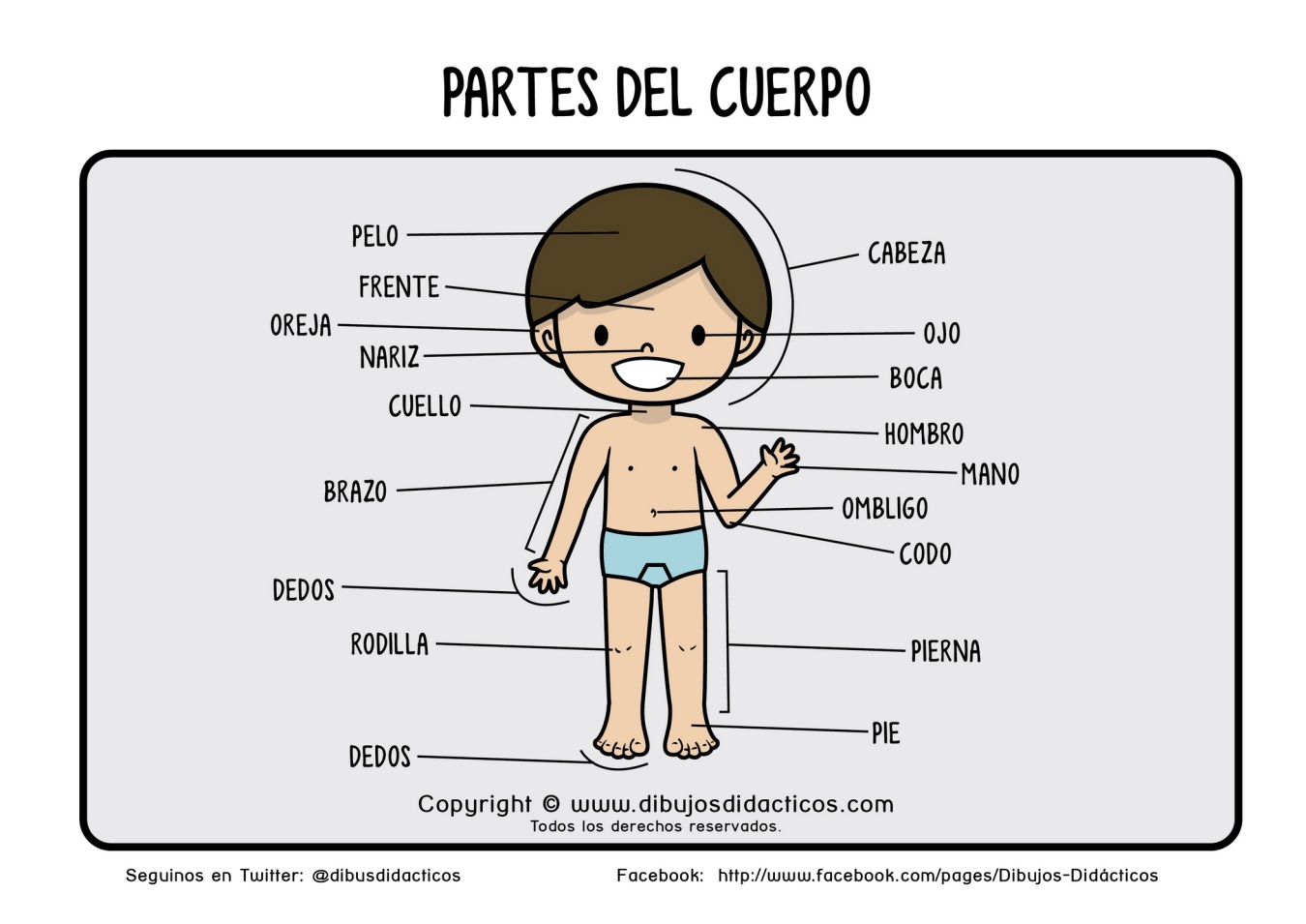

APPENDIX 9: ACTIVITY OF NUMBERS AND COLORS APPLIED
¿Tlono ti kon Ita?
Pedro ihuan niknih Maria mahuiltiya ompa ixtlahuatk. Ompa kuale na kon tazke miyik yolkameh. Xkon pohuaka keskime kahte ihuan xkon ihkuiloka in tlahpohuali ipan cakajastzin.
¿Keski tochtle t’kon ita?
¿keski chochokotzitzin t’kon ita?
¿keski mazame t’kon ita?
¿Keski michime t’kon ita?
¿keski yoyolkatzitzi t’kon ita?
¿keski auitsome t’kon ita?
¿
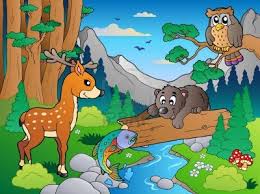
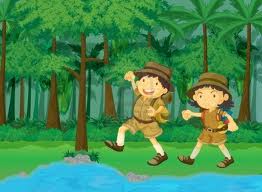
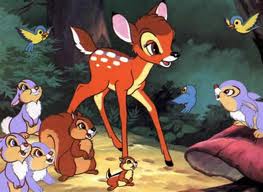 keski
tekuanotl t’kon ita?
keski
tekuanotl t’kon ita?
